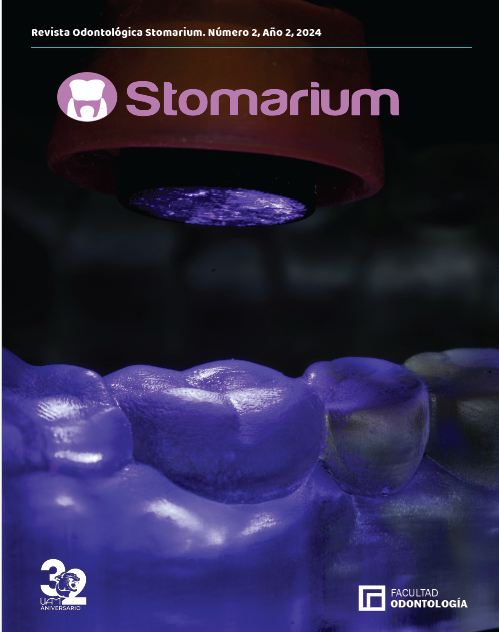Case Report of a Free Gingival Graft to Improve Keratinized Gingiva Around Implants
DOI:
https://doi.org/10.62407/ros.v2i2.176Keywords:
Free gingival graft, dental implants, keratinized gingiva, periodontal plastic surgeryAbstract
This clinical report describes the surgical management of a patient with a deficiency of keratinized tissue around implants placed in positions 3.5 and 3.6. Insufficient keratinized tissue can compromise peri-implant health, hinder oral hygiene, and increase the risk of inflammation and marginal bone loss. To address this condition, a free gingival graft (FGG) harvested from the palate was performed to enhance the amount of keratinized gingiva and improve peri-implant conditions. The procedure included careful surgical planning, preparation of the recipient site, and suturing of the graft in place. Specific postoperative instructions were provided, and short- and mid-term follow-ups were conducted to evaluate graft integration and esthetic and functional outcomes.
Downloads
References
Adell, R., Lekholm, U., Rockler, B., Brånemark, P. I., Lindhe, J., Eriksson, B., & Sbordone, L. (1986). Marginal tissue reactions at osseointegrated titanium fixtures. International Journal of Oral and Maxillofacial Surgery, (15)1 39–52. https://doi.org/10.1016/S0300-9785(86)80010-2
Artzi, Z., Tal, H., Moses, O., & Kozlovsky, A. (1993). Mucosa considerations for osseointegrated implants. Journal of Prosthetic Dentistry, (70)5, 427-432. https://doi.org/10.1016/0022-3913(93)90079-4
Basualdo, J., & Niño, A. Y. (2015). Necrosis de injerto de tejido conectivo subepitelial asociado a incompetencia labial: Reporte de un caso clínico. Revista Clínica de Periodoncia, Implantología y Rehabilitación Oral, 8(1), 73–78. http://dx.doi.org/10.1016/j.piro.2014.09.006.
Bassetti, R. G., Stähli, A., Bassetti, M. A., & Sculean, A. (2016). Soft tissue augmentation procedures at second-stage surgery: A systematic review. Clinical Oral Investigations, 20(7). https://doi.org/10.1007/s00784-016-1815-2
Bengazi, F., Botticelli, D., Favero, V., Perini, A., Urbizo Vélez, J., & Lang, N. P. (2014). Influence of presence or absence of keratinized mucosa on the alveolar bony crest level as it relates to different buccal marginal bone thicknesses: An experimental study in dogs. Clinical Oral Implants Research, 25(9). https://doi.org/10.1111/clr.12233
Benghazi, F., Lang, N. P., Caroprese, M., Urbizo Vélez, J., Favero, V., & Botticelli, D. (2015). Dimensional changes in soft tissues around dental implants following free gingival grafting: An experimental study in dogs. Clinical Oral Implants Research, 26(2), 176–182. https://doi.org/10.1111/clr.12280
Berglundh, T., Lindhe, J., Ericsson, I., Marinello, C. P., Liljenberg, B., & Thomsen, P. (1991). The soft tissue barrier at implants and teeth. Clinical Oral Implants Research, 2(2), 81–90. https://doi.org/10.1034/j.1600-0501.1991.020206.x
Cairo, F., Pagliaro, U., & Nieri, M. (2008). Soft tissue management at implant sites. Journal of Clinical Periodontology, 35(8 Suppl), 163–167. https://doi.org/10.1111/j.1600-051X.2008.01266.x
Chung, D. M., Oh, T.-J., Shotwell, J. L., Misch, C. E., & Wang, H.-L. (2006). Significance of keratinized mucosa in maintenance of dental implants with different surfaces. Journal of Periodontology, 77(8), 1410–1420. https://doi.org/10.1902/jop.2006.050393
Cranin, A. N. (2002). Implant surgery: The management of soft tissues. Journal of Oral Implantology, 28(5), 230–237. https://doi.org/10.1563/1548-1336(2002)028<0230:ISTMOS>2.3.CO;2
Deeb, G. R., & Deeb, J. G. (2015). Soft tissue grafting around teeth and implants. Oral and Maxillofacial Surgery Clinics of North America, 27(3), 425–448. https://doi.org/10.1016/j.coms.2015.04.010
Fickl, S. (2015). Peri-implant mucosal recession: Clinical significance and therapeutic opportunities. Quintessence International, 46(8). https://doi.org/10.3290/j.qi.a34397.
Lin, G.-H., Chan, H.-L., & Wang, H.-L. (2013). The significance of keratinized mucosa on implant health: A systematic review. Journal of Periodontology, (84) 12 1755-67. https://doi.org/10.1902/jop.2013.120688
Mörmann, W., Schaer, F., & Firestone, A. R. (1981). The relationship between success of free gingival grafts and transplant thickness: Revascularization and shrinkage—A one-year clinical study. Journal of Periodontology, 52(2), 74–80. https://doi.org/10.1902/jop.1981.52.2.74
Squier, C. A., & Kremer, M. J. (2001). Biology of oral mucosa and esophagus. Journal of the National Cancer Institute Monographs, (29), 7–15. https://doi.org/10.1093/oxfordjournals.jncimonographs.a003443
Sullivan, H. C., & Atkins, J. H. (1968). Free autogenous gingival grafts. I. Principles of successful grafting. Periodontics, 6(3), 121–129.
Grover, H. S., Yadav, A., Yadav, P., & Nanda, P. (2011). Free gingival grafting to increase the zone of keratinized tissue around implants. International Journal of Oral Implantology & Clinical Research, 2(2), 117–120. https://www.ijoicr.com/doi/IJOICR/pdf/10.5005/jp-journals-10012-1046
Zigdon, H., & Machtei, E. E. (2008). The dimensions of keratinized mucosa around implants affect clinical and immunological parameters. Clinical Oral Implants Research, 19(4), 387–392. https://doi.org/10.1111/j.1600-0501.2007.01492.x
Zucchelli, G., Tavelli, L., McGuire, M. K., Rasperini, G., Feinberg, S. E., Wang, H.-L., & Giannobile, W. V. (2020). Autogenous soft tissue grafting for periodontal and peri-implant plastic surgical reconstruction. Journal of Periodontology, 91(1), 9–16. https://doi.org/10.1002/JPER.19-0350
Published
How to Cite
Issue
Section
License

This work is licensed under a Creative Commons Attribution-NonCommercial-ShareAlike 4.0 International License.




